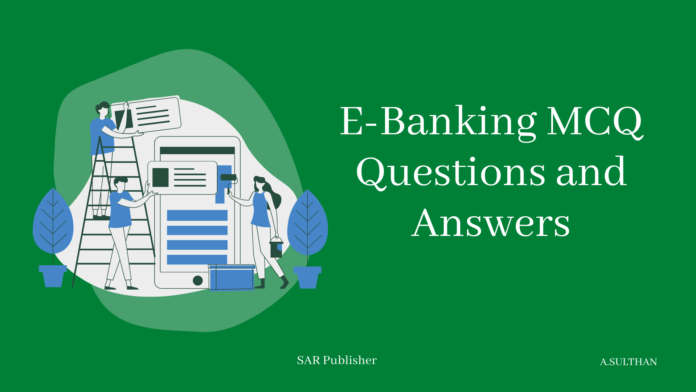E-Banking MCQ Questions and Answers Part – 1
E-Banking MCQ Questions and Answers Part – 2
E-Banking MCQ Questions and Answers Part – 3
1. A cheque dated subsequent to the date of its issue is ___________.
A. post dated cheque
B. blank cheque
C. crossed cheque
D. account payee cheque
ANSWER: A
2. A cheque date before the date of its issue is ___________.
A. ante dated cheque.
B. full worth cheque
C. preemptive cheque.
D. worth cheque
ANSWER: A
3. A drawer can also be a _________.
A. Payee.
B. paymaster.
C. banker
D. creditor
ANSWER: A
4. The rate at which RBI discounts approved bill of exchange is ___________.
A. bank rate
B. interest rate
C. exchange rate
D. discount rate
ANSWER: D
5. _____ headed the committee on Computerization in Indian banks (1988).
A. M. Narasimhan.
B. M.M. Shah.
C. M. Venkat Ram
D. Raj Foster
ANSWER: A
6. The Word Bank has been derived from a Latin word which means _______.
A. a bench for the keeping, lending and exchanging etc. of money.
B. an institution for meeting people.
C. place, where persons can relax
D. an institution for coordinating people
ANSWER: A
7. A company who accepts demand deposit is called ___________.
A. banking company
B. joint stock company
C. manufacturing company
D. IT company
ANSWER: A
8. The lien is __________.
A. method to create charge over customers property
B. not used for respective customers account.
C. not used for loan
D. used for loan
ANSWER: A
9. One rupee notes bear the signature of ______.
A. president of India
B. prime minister of India
C. governor of Reserve Bank of India
D. secretary, Ministry of finance (Government of India).
ANSWER: D
10. Small coin depot is the property of _____.
A. State bank of India
B. Government of India
C. Reserve bank of India
D. Indian bank.
ANSWER: B
11. A Banking company whose license is cancelled may appeal to the ___.
A. High court.
B. Supreme court
C. RBI.
D. Central government
ANSWER: D
12. Who controls credit in India?
A. Government of India.
B. RBI.
C. SBI.
D. Indian bank
ANSWER: B
13. RBI grants for agricultural purposes _____.
A. only short term finance.
B. medium and long term finance.
C. short and medium-term finance only
D. short, medium and long term finance
ANSWER: C
14. The apex institution in agricultural finance is______.
A. NABARD
B. EXIM bank
C. RBI
D. IDBI
ANSWER: A
15. Development banks are institutions which _____.
A. give development loans
B. provide emergency loans of banks
C. are subsidiaries of RBI
D. provide term finance to industries
ANSWER: B
16. IFCI was established in _____.
A. 1947.
B. 1948
C. 1951
D. 1956.
ANSWER: B
17. IFCI has its registered office in _______.
A. Bombay
B. Madras
C. Newdelhi
D. Calcutta.
ANSWER: B
18. National industrial development corporation Ltd, was established in _____.
A. 1954
B. 1955
C. 1956
D. 1964
ANSWER: A
19. LIC was set up in _______.
A. 1948
B. 1951
C. 1956
D. 1964
ANSWER: C
20. ICICI was incorporated in ______.
A. 1948
B. 1955
C. 1956
D. 1964
ANSWER: B
21. Negotiable instruments are defined under ______.
A. Section 52 of the Banking regulation act, 1949
B. Section 25 of the Reserve bank of India act, 1934.
C. Section 13 of the Negotiable instruments act, 1881.
D. Section 14 of the companies act, 1956.
ANSWER: C
22. Who is primarily liable on a promissory note?
A. Holder.
B. Maker.
C. Drawee.
D. Endorser.
ANSWER: B
23. A Cheque is always payable on _______.
A. demand.
B. a specified future date
C. the last day of the grace.
D. the will of the paying banker.
ANSWER: A
24. A promissory note _____.
A. can be drawn in sets
B. cannot be drawn in sets
C. indemnity bond is also necessary.
D. indemnity bond is not necessary.
ANSWER: B
25. In a promissory note the words or order are ______.
A. necessary to insert.
B. not necessary to insert
C. not necessary but it is usual to insert
D. necessary it is usual
ANSWER: C
26. Bill of exchange can be drawn payable _______.
A. to bearer on demand
B. either on demand or after a fixed time
C. to bearer in presence
D. to bearer not in presence.
ANSWER: B
27. Until a bill of exchange is accepted, primary liability there on is that of _____.
A. Payee.
B. Drawee.
C. Drawer.
D. Acceptor.
ANSWER: C
28. A bill of exchange is drawn for a maximum period of ____.
A. 90 days.
B. 120 days.
C. 180 days.
D. 360 days.
ANSWER: C
29. Expansion of HDFC ___________.
A. Housing Development Finance Corporation
B. Housing Development Finance Company
C. Housing Development Finance Co-operative
D. Housing Development Finance Community
ANSWER: A
30. Negotiable gives to the transferee _____.
A. the same title
B. no title
C. no better title
D. better title
ANSWER: D
31. __________ is a dead cheque.
A. Post dated cheque
B. Stale cheque.
C. Ante dated cheque.
D. Pre dated cheque
ANSWER: B
32. RBI refers to _________.
A. Reserve Bank of India.
B. Revenue Bank of India.
C. Rupee Bank of India
D. Regional Bank of India
ANSWER: A
33. Name the person to whom the amount of the cheque is payable?
A. Drawer.
B. Payee.
C. Drawee.
D. Acceptor
ANSWER: C
34. Which is a private bank?
A. SBI.
B. UTI
C. IOB.
D. Indian bank.
ANSWER: B
35. The best suited deposit for trading community is _____.
A. Savings deposit
B. Current deposit.
C. Fixed deposit
D. RD.
ANSWER: B
36. A pledge can be made in respect of _____.
A. building.
B. shares.
C. motor car.
D. book debts
ANSWER: B
37. A collecting banker is given the statutory protection only when he acts as ___.
A. a holder
B. an agent.
C. a holder for value.
D. a holder in due course.
ANSWER: D
38. The law of limitation applies to a saving deposit account from the date of _____.
A. opening it.
B. closing it.
C. demanding it.
D. operating it.
ANSWER: A
39. The most liquid asset is ______.
A. gold.
B. bill of exchange.
C. government bonds.
D. cash.
ANSWER: D
40. According to IBA the maximum period for which fixed deposits can be obtained is ______.
A. no limit
B. 5 years
C. 7 years
D. 10 years
ANSWER: C
41. The right of set – off is nothing but a ______.
A. right to sell.
B. right to retain.
C. right to combine
D. right to appropriate
ANSWER: C
42. Discounting of bills of exchange is ____.
A. clean advance
B. secured advance
C. neither clean advance nor secured advance.
D. unsecured advance
ANSWER: C
43. Expansion of SWIFT is ______.
A. Society for worldwide inter bank financial telecommunication
B. Security for worldwide inter bank financial telecommunication
C. Secured for worldwide inter bank financial telecommunication
D. Safety for worldwide inter bank financial telecommunication.
ANSWER: A
44. Expansion of NEFT_______.
A. National Electronic Fund Transfer.
B. Neutral Electronic Fund Transfer.
C. Nominal Electronic Fund Transfer.
D. Natural Electronic Fund Transfer.
ANSWER: A
45. Expansion of EFT_________.
A. Electronic Fund Transfer
B. Economic Fund Transfer.
C. European Fund Transfer
D. Electric Fund Transfer.
ANSWER: A
46. RTGS system works _________ days in a year
A. 365.
B. 362
C. 300.
D. 305.
ANSWER: B
47. KYC means________.
A. know your customer.
B. know your creditor.
C. know your cost.
D. know your card.
ANSWER: A
48. The first bank in India to be given an ISO certificate _________.
A. Canara bank
B. SBI.
C. central bank of India.
D. Indian bank
ANSWER: A
49. The first Indian bank to open branch outside India ______.
A. Bank of India
B. Allahabad bank.
C. south Indian bank
D. Indian bank
ANSWER: A
50. RTGS means _______.
A. Real Time Gross Settlement.
B. Real Turn Gross Settlement.
C. Real Technique Gross Settlement
D. Real Towards Gross Settlement
ANSWER: A


